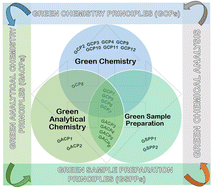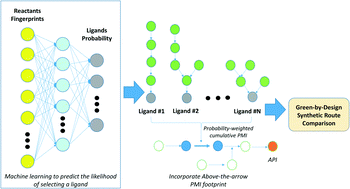Themed collection Measuring Green Chemistry: Methods, Models, and Metrics

Measuring green chemistry: methods, models, and metrics
This themed collection includes selected examples aiming to quantify the benefits and trade-offs of green chemistry by providing assessment methods, models, indicators, and metrics.

Green Chem., 2024,26, 11016-11018
https://doi.org/10.1039/D4GC90118E
What does it mean that “something is green”? The fundamentals of a Unified Greenness Theory
Proposal of a general theory of greenness, connecting all chemical disciplines and not only; the description of basic concepts and relationships.

Green Chem., 2023,25, 4625-4640
https://doi.org/10.1039/D3GC00800B
Education in green chemistry and in sustainable chemistry: perspectives towards sustainability
Central role of future professionals in chemistry to promote alternatives towards sustainability.

Green Chem., 2021,23, 1594-1608
https://doi.org/10.1039/D0GC03313H
Green metrics in mechanochemistry
The quantitative assessment of the greenness of mechanochemical processes for green metrics were calculated is herein reported. A general introduction to the topic, variables influencing the reaction outcome and, an outlook are also provided.

Chem. Soc. Rev., 2023,52, 6680-6714
https://doi.org/10.1039/D2CS00997H
Chemical data intelligence for sustainable chemistry
This study highlights new opportunities for optimal reaction route selection from large chemical databases brought about by the rapid digitalisation of chemical data.

Chem. Soc. Rev., 2021,50, 12013-12036
https://doi.org/10.1039/D1CS00477H
Conservative evolution and industrial metabolism in Green Chemistry
Chemical substances and processes that play a fundamental role in the 12 principles of Green Chemistry representing conservative evolution and/or industrial metabolism were reviewed.

Green Chem., 2018,20, 2171-2191
https://doi.org/10.1039/C8GC00514A
Safe and sustainable chemicals and materials: a review of sustainability assessment frameworks
Indicators and methods for safe and sustainable by design chemicals and materials.

Green Chem., 2024,26, 7456-7477
https://doi.org/10.1039/D3GC04598F
Chemical recycling of polyester textile wastes: shifting towards sustainability
Amongst all synthetic polymers used in the clothing industry, polyethylene terephthalate (PET) is the most widely used polyester, its fibres representing half the total PET global market (in comparison bottle PET being less than a third).

Green Chem., 2024,26, 6857-6885
https://doi.org/10.1039/D4GC00911H
Green chemical analysis: main principles and current efforts towards greener analytical methodologies
Green chemistry, green analytical chemistry and green sample preparation are related areas that have been developing since the 90s, aiming to moderate the adverse impacts of chemical practices on the environment and human health.

Anal. Methods, 2023,15, 6631-6642
https://doi.org/10.1039/D3AY01644G
Classic vs. C–H functionalization strategies in the synthesis of APIs: a sustainability comparison
This review present case studies analyzed in terms of waste production and environmental/safety hazard aiming at quantify whether the adoption of C–H functionalization technology is actually the most effective strategy compared to classic approaches.

Green Chem., 2023,25, 7916-7933
https://doi.org/10.1039/D3GC02516K
The E factor at 30: a passion for pollution prevention
Publication of the E Factor drew attention to the problem of waste in chemicals manufacture. Thirty yeas later it is abundantly clear that waste is the underlying cause of global environmental problems, from climate change to plastic pollution.

Green Chem., 2023,25, 1704-1728
https://doi.org/10.1039/D2GC04747K
Sustainability of green solvents – review and perspective
Life cycle of an ideal green solvent from cradle to grave for sustainability studies of green solvents.

Green Chem., 2022,24, 410-437
https://doi.org/10.1039/D1GC03662A
The Green ChemisTREE: 20 years after taking root with the 12 principles
A broad overview of the achievements and emerging areas in the field of Green Chemistry.

Green Chem., 2018,20, 1929-1961
https://doi.org/10.1039/C8GC00482J
Environmental and economical perspectives of a glycerol biorefinery
Process assessment uncovers most state-of-the-art glycerol-valorisation technologies as attractive, unravels critical parameters for optimisation and highlights advantages of integration within a biorefinery.

Energy Environ. Sci., 2018,11, 1012-1029
https://doi.org/10.1039/C7EE03116E
Inspiring process innovation via an improved green manufacturing metric: iGAL

Green Chem., 2018,20, 2206-2211
https://doi.org/10.1039/C8GC00616D
The need to integrate mass- and energy-based metrics with life cycle impacts for sustainable chemicals manufacture
Analysis of over 700 chemical production routes showing that decision making towards more environmentally sustainable pathways is enhanced by combining mass- and energy-based process metrics with simplified life cycle impact indicators.

Green Chem., 2024,26, 9300-9309
https://doi.org/10.1039/D4GC00394B
Interactions of multiple metrics and environmental indicators to assess processes, detect environmental hotspots, and guide future development
Sustainable development of pharmaceuticals relies on the selection and integration of unified metrics and indicators. Herein, we present a standardized method to assess, report, and communicate environmental sustainability of development processes.

Green Chem., 2024,26, 5239-5252
https://doi.org/10.1039/D4GC00302K
Evaluation of green chemistry metrics for sustainable recycling of platinum group metals from spent automotive catalysts via bioleaching
This work evaluates the sustainability indicators of the biorecovery of platinum group metals from spent automotive catalysts with due consideration of the environment and efficiency for the evaluation of environmental sustainability.

Green Chem., 2024,26, 4112-4126
https://doi.org/10.1039/D3GC03918H
Solvent selection based on a conceptual process design by combining cost evaluation and life cycle assessments for developing new reaction pathways
Solvent selection combined with conceptual process design is the key to developing sustainable chemical production.

Green Chem., 2024,26, 3758-3766
https://doi.org/10.1039/D3GC04293F
Optimization of analytical method greenness scores: a case study of amino acid enantioseparations with carbonated aqueous systems
Analytical and preparative separation techniques, although perceived as less detrimental compared to industrial manufacturing processes, present a substantial concealed environmental threat.

Green Chem., 2024,26, 760-770
https://doi.org/10.1039/D3GC03005A
The sustainability impact of Nobel Prize Chemistry: life cycle assessment of C–C cross-coupling reactions
Carbon-to-carbon (C–C) cross-coupling reaction (CCR) protocols represent a major breakthrough in synthetic chemistry.

Green Chem., 2023,25, 9760-9778
https://doi.org/10.1039/D3GC01896B
Blue applicability grade index (BAGI) and software: a new tool for the evaluation of method practicality
In this work, blue applicability grade index (BAGI) is proposed as a new metric tool for evaluating the practicality of an analytical method.

Green Chem., 2023,25, 7598-7604
https://doi.org/10.1039/D3GC02347H
Environmental profile of the production of fragrance ingredients used in cosmetic products: comparative analysis of results obtained by life cycle assessment and the green chemistry-based eco-design tool GREEN MOTION™
Environmental footprint evaluation of representative fragrance ingredients combining 2 complementary methodologies in the aim of providing a new method to eco-design fragrances, which are materials found in many commercialized daily-life products.

Green Chem., 2023,25, 6365-6382
https://doi.org/10.1039/D2GC04860D
Conversion of plastic waste into high-value lubricants: techno-economic analysis and life cycle assessment
The conversion of plastic waste into high-quality lubricants is more profitable than sorting the waste or converting it into liquid fuels. A life cycle assessment showed that the emissions were lower than those of petroleum lubricants of similar quality.

Green Chem., 2022,24, 6306-6318
https://doi.org/10.1039/D2GC01840C
Techno-economic performances and life cycle greenhouse gas emissions of various ammonia production pathways including conventional, carbon-capturing, nuclear-powered, and renewable production
The techno-economic performances and life cycle greenhouse gas emissions of conventional NG-based, carbon-capturing, and nuclear-powered or renewable ammonia production are evaluated.

Green Chem., 2022,24, 4830-4844
https://doi.org/10.1039/D2GC00843B
Planetary metrics for the absolute environmental sustainability assessment of chemicals
We provide guidelines for performing absolute environmental sustainability assessments (AESA) of chemicals based on the planetary boundaries and classifying them as sustainable or unsustainable, and use them to evaluate 492 chemical products.

Green Chem., 2021,23, 9881-9893
https://doi.org/10.1039/D1GC02623B
Organic syntheses greenness assessment with multicriteria decision analysis
Greenness metrics for comparative, comprehensive and simple assessment of organic syntheses processes.

Green Chem., 2021,23, 9583-9588
https://doi.org/10.1039/D1GC03108B
Complementary green analytical procedure index (ComplexGAPI) and software
It is not easy to find appropriate tools for the evaluation of the “green” nature of analytical methodologies which involve the use of compounds, materials, or chemicals manufactured prior to the analytical step.

Green Chem., 2021,23, 8657-8665
https://doi.org/10.1039/D1GC02318G
Comparing the greenness and sustainability of three routes to an HIV protease inhibitor intermediate
The greenness and sustainability of three different routes for the synthesis of an advanced intermediate for a group of HIV protease inhibitors used in antiretroviral (ARV) therapy are compared.

Green Chem., 2021,23, 3334-3347
https://doi.org/10.1039/D1GC00986A
E-factor analysis of a pilot plant for end-to-end integrated continuous manufacturing (ICM) of pharmaceuticals
Much less waste was generated by the end-to-end Integrated Continuous Manufacturing (ICM) process compared to the batch process.

Green Chem., 2020,22, 4350-4356
https://doi.org/10.1039/D0GC01397H
Hybridised sustainability metrics for use in life cycle assessment of bio-based products: resource efficiency and circularity
Demonstration of an innovative environmental assessment methodology that provides a unique dimension to sustainability reporting, focusing on circular bio-based value chains.

Green Chem., 2020,22, 803-813
https://doi.org/10.1039/C9GC02992C
Why we might be misusing process mass intensity (PMI) and a methodology to apply it effectively as a discovery level metric
Are the comparisons of PMI values fair and informative, are you making a like versus like assessment?

Green Chem., 2020,22, 123-135
https://doi.org/10.1039/C9GC01537J
ReGreen SPPS: enabling circular chemistry in environmentally sensible solid-phase peptide synthesis
A cost and synthetic efficient method that enables facile reagent and solvent recycling in SPPS using cross-linked polystyrene resins in greener solvents is reported.

Green Chem., 2019,21, 5990-5998
https://doi.org/10.1039/C9GC02775K
Making better decisions during synthetic route design: leveraging prediction to achieve greenness-by-design
A conceptual framework for incorporating machine learned ligand prediction into predictive route comparisons, to enable greener chemistry outcomes.

React. Chem. Eng., 2019,4, 1595-1607
https://doi.org/10.1039/C9RE00019D
Life-cycle assessment and techno-economic analysis of the utilization of bio-oil components for the production of three chemicals
Bio-based chemicals have gained more widespread attention than bio-fuels because of the decline in crude oil prices.

Green Chem., 2018,20, 3287-3301
https://doi.org/10.1039/C8GC01181H
Evaluating the greenness of alternative reaction media
The application of alternative reaction media (ionic liquids, carbohydrate–urea melts, solvent-free alternative) in a Diels–Alder reaction is evaluated and compared to conventional solvents with the help of an economic and ecological screening method in order to accentuate opportunities and challenges.

Green Chem., 2008,10, 1170-1181
https://doi.org/10.1039/B807379A
About this collection
This cross-journal-themed collection showcases selected examples aiming to quantify the benefits and trade-offs of green chemistry by providing assessment methods, models, indicators, and metrics. The collection is intended as a guide and accessible resource for the whole chemical community while helping authors to measure, compare, and describe the advantages and disadvantages of introducing green chemistry principles and approaches in their work.
The collection includes, but is not limited to, examples of application of green chemistry principles as well as methods for measuring their efficacy in improving chemicals or in selecting a preferred alternative, such as E factor, green analytical procedure Index (GAPI) processes, process mass intensity, eco-scale, techno-economic analysis, life-cycle assessment, carbon balance analysis. The collection entails example of application of individual metrics and indicators as well as multicriteria assessment and addresses as well green chemistry education.
Guest Edited and curated by: André Bardow (ETH Zürich), Javier Pérez-Ramírez, (ETH Zurich), Serenella Sala (European Commission - Joint Research Centre) and Luigi Vaccaro (University of Perugia)